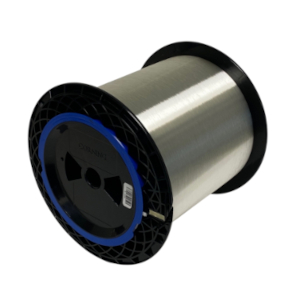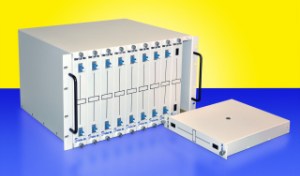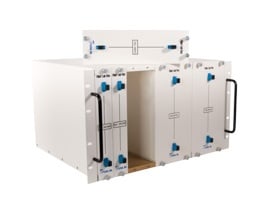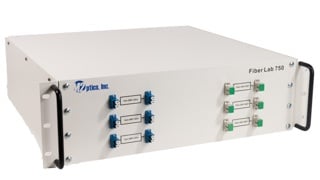For most people working in the fiber optic communications field, their experience with optical fiber involves using jacketed fiber optic cables. This includes network and data center infrastructure cabling, which may contain hundreds of fibers in each cable, as well as patch cables with fewer fibers used for connecting devices. Due to the multi-fiber nature of jacketed cables and network devices such as optical transceivers, which require a Tx/Rx fiber pair cabling connection, it's commonplace for many people to think of spooled bare optical fibers for network simulation testing and optical delay applications in a similar format. Additionally, since the fiber manufacturers provide maximum signal attenuation/loss specifications for a fiber, there is sometimes a misconception that the resulting performance will always be within that defined specification when using spooled and terminated bare optical fibers.
Read More
Topics:
network simulation,
optical time delays,
bare optical fiber,
optical fiber attenuation,
optical fiber tension
In this article, we discuss the role that Chromatic Dispersion (CD) plays when simulating the optical and latency performance of fiber spans during RF-over-Fiber (RFoF) testing procedures, along with introducing valuable strategies for effectively mitigating its detrimental impacts.
Read More
Topics:
fiber optic testing,
dispersion compensating fiber,
RFoF,
optical time delays,
RF-over-Fiber
Fiber-to-the-home (FTTH), also known as fiber-to-the-premises (FTTP), is when optical fiber is installed and connected directly to a single structure, such as a home, apartment, or business. This approach for delivering high-speed internet services and greater bandwidth continues to excel globally as it offers superior performance compared to non-fiber coaxial cable and DSL (Digital Subscriber Line) connections.
Read More
Topics:
WDM,
fiber optic testing,
optical fiber,
otdr,
PON,
optical switching,
fiber optic training,
fiber lab,
network simulation,
optical taps,
fiber monitoring,
optical time delays,
Optical fiber market,
fiber optic cable,
fiber optic networks
Latency is a critical performance factor in communications networks as it is the time it takes for data to travel from one point to another. As one might expect, service providers commit a great deal of time and effort attempting to reduce latency across the entire network, to deliver data and content faster to consumers and businesses. While important in general, some applications like financial trading, streaming video, and defense/military communications prioritize latency reduction with the goal of achieving as close to real-time communications as possible.
Read More
Topics:
optical fiber,
latency,
optical time delays
Optical fiber serves as the primary medium for transmitting data in today's high-speed communications networks and latency, one of the most critical performance measurements, is the time it takes for a light signal to travel from one point to another. While there are numerous factors that contribute to this value like installed devices when looking at overall network latency, the time delay incurred during light transmission across the fiber itself, also known as fiber latency, is a significant component in the equation.
Read More
Topics:
optical fiber,
optical time delays,
calculate latency
What is the Dynamic Range of an OTDR?
When certifying or troubleshooting optical fibers in a network using an OTDR, the Dynamic Range is a key parameter of the device that determines the maximum length of the fiber that is observed during a test trace. In more technical terms, it is the distance between the point of the initial backscatter and the noise floor at the end of the fiber under test. The dynamic range value is measured and expressed in decibels (dB) and is essentially an analysis of power levels. OTDRs offering a larger dynamic range value can test longer lengths of fiber compared to those offering a smaller dynamic range value. Therefore, equating a dynamic range value with a fiber distance value is important when evaluating or specifying an OTDR for testing fibers in a network.
Calculating Dynamic Range
At the most basic level, the calculation relationship for equating a dynamic range value to a fiber distance includes three components:
Read More
Topics:
optical fiber,
otdr,
optical time delays
Radio Frequency over Fiber (RFoF) is a critical component in industries such as aerospace, radar, broadcasting, satellite and GPS communications, along with weight-sensitive environments such as the space or undersea industries. With RF over fiber, radio communication is consistent and reliable.
Read More
Topics:
RFoF,
optical time delays
For many years, communications network equipment manufacturers performed most of the lab testing efforts when designing and certifying their gear for use in the field by their customers. Now that fiber optic systems are the norm around the world for driving communications, many of the equipment users themselves are testing potential devices before deployment to determine the best solution for their own unique needs. Financial service providers, utilities, local governments, and smaller regional internet providers have recognized that having even a small and efficient lab setup where they can simulate their network and train technicians can go a long way in optimizing their operations.
Read More
Topics:
fiber optic training,
network simulation,
optical time delays
This year’s OFC conference in San Diego will be another showcase of innovative new and future technologies. With fiber optic communication and networking equipment continuing to evolve, testing procedures and setups must also grow and change as part of the process. Engineers are then often faced with a challenge - how can they continue to add and integrate new systems and the appropriate connectivity infrastructure in a finite amount of lab space? While some may benefit from new facility expansions, the luxury of additional square footage and rack space isn't often the case for most.
Read More
Topics:
fiber optic testing,
optical fiber,
optical time delays
The versatile Fiber Lab 750 from M2 Optics offers multiple lengths of optical fiber in just 3RU, saving 50% or more rack space for engineers.
Read More
Topics:
latency,
optical time delays













